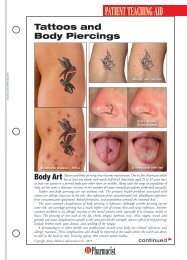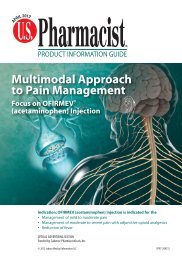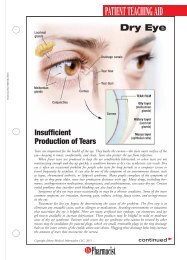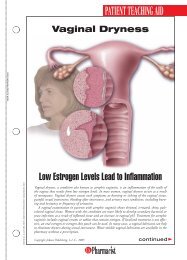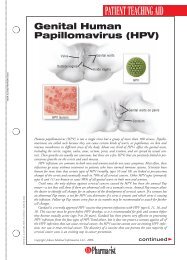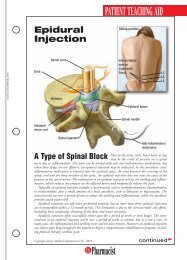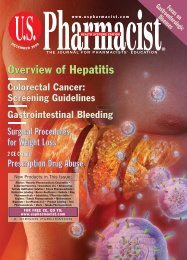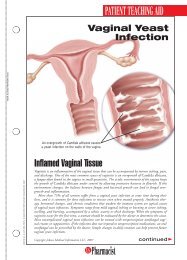View PDF Edition - U.S. Pharmacist
View PDF Edition - U.S. Pharmacist
View PDF Edition - U.S. Pharmacist
You also want an ePaper? Increase the reach of your titles
YUMPU automatically turns print PDFs into web optimized ePapers that Google loves.
Table 1Early Barriers PreventingUtilization of EC Methods• Lack of awareness by consumers that a method toprevent pregnancy after intercourse was available• Failure of doctors to discuss EC during medicalappointments• Lack of information about EC among health careprofessionals• Misconceptions about how EC works• Confusion of EC and the “abortion pill”• Difficulty obtaining EC by prescription within thenarrow window of efficacyriers that limit the use of EC by improving patient accessand being available to answer questions about the useof EC. <strong>Pharmacist</strong>s, as the “most accessible” healthcare provider, are in a unique position and play a crucialrole in providing timely access to and informationabout EC to consumers. OTC availability in the pharmacyto consumers age 17 and over improves access toEC by reducing the delays that were associated withobtaining a prescription in the limited time frame neededfor efficacy of the product.EMERGENCY CONTRACEPTION: AN UPDATETable 2Products Approved for Emergency ContraceptionLevonorgestrelBrand Manufacturer Dose per Dose (mg)One-Dose RegimenPlan B One-Step Barr Pharmaceuticals 1 tablet per dose 1.5Two-Dose Regimens (administered immediately and 12 h later)Plan BBarr PharmaceuticalsNext Choice Watson Pharmaceuticals 1 tablet per dose 0.75Background and Clinical History of ECLevonorgestrel has been extensively studied as anemergency contraceptive worldwide since the 1970s.After almost 40 years of EC use, the high degree ofefficacy in preventing pregnancy (up to 89% reduction)and the low rate of adverse effects have been well documented.5,7-10 A 2009 update to a Cochrane review ofEC interventions included more than 88 studies andconcluded that levonorgestrel is both safe and effectivein preventing pregnancy after intercourse. 7The first products approved by the FDA for EC werePreven (ethinyl estradiol 0.25 mg/levonorgestrel 0.5 mgtablets) in 1998 and Plan B (levonorgestrel 0.75 mgtablets) one year later. Both products were approved foruse by prescription and to be taken in a two-dose regimeninitiated within 72 hours of unprotected intercourse.Despite FDA approval, an increase in the utilizationof EC by women was hampered by a numberof barriers (TABLE 1).To improve access, a request was made to move PlanB to OTC status. Plan B appeared to satisfy FDA requirementsfor conversion from prescription to OTC status,which include a minimum of two years of prescriptionuse with a high degree of safety and studies establishingthat consumers can interpret labeled instructions correctly.Although an FDA Advisory Committee voted in2003 in support of the request for nonprescriptionstatus, the FDA approved a change for Plan B in 2006to “dual status” instead. 11 Under dual status, Plan B wasmade available without prescription to consumers at orabove a certain age (originally 18 years but now 17) andremained available by prescription to younger women.Packaging for the product was approved to meet therequirements for both prescription and nonprescriptionproducts. Since then, Next Choice and Plan B One-Step have also been approved for dual status distributionin pharmacies and clinics (TABLE 2).Before the approval of dedicated products for EC,commercially available oral contraceptives containingethinyl estradiol with either norgestrel or levonorgestrel(often referred to as the “Yuzpe regimen”) were used forEC. More recent studies have shown these combinationsto be less effective (ranging from 49% to 75%)than levonorgestrel-only regimens. 7,9 Furthermore,the Yuzpe regimen has more side effects, especially nauseaand vomiting, which often require the addition ofan antiemetic medication. Production of Preven, a commerciallyavailable equivalent to the Yuzpe regimen, wasstopped in 2004. Because of its lower efficacy andincreased frequency of side effects, use of the Yuzpe typecombination regimens has declined but remains anoption when levonorgestrel is not available.Several other methods have been evaluated for EC,including combinations of estrogen with norethindrone,combining levonorgestrel with the COX-2 inhibitormeloxicam, Yuzpe or levonorgestrel regimens using differenttime intervals or doses, insertion of a copper IUD,an investigational progesteronemodulator ulipristal (availableas ellaOne in Europe) andlow doses of mifepristone. 7,12Combination regimens usingnorethindrone appear to be lesseffective than levonorgestrelregimens. 13 Regimens usingmifepristone in doses rangingfrom 10 mg to 50 mg appearto be effective; however, thesedoses are not available in theU.S. 7 Insertion of a copper IUDup to 10 days after intercourse71U.S. <strong>Pharmacist</strong> • November 2009 • www.uspharmacist.com




